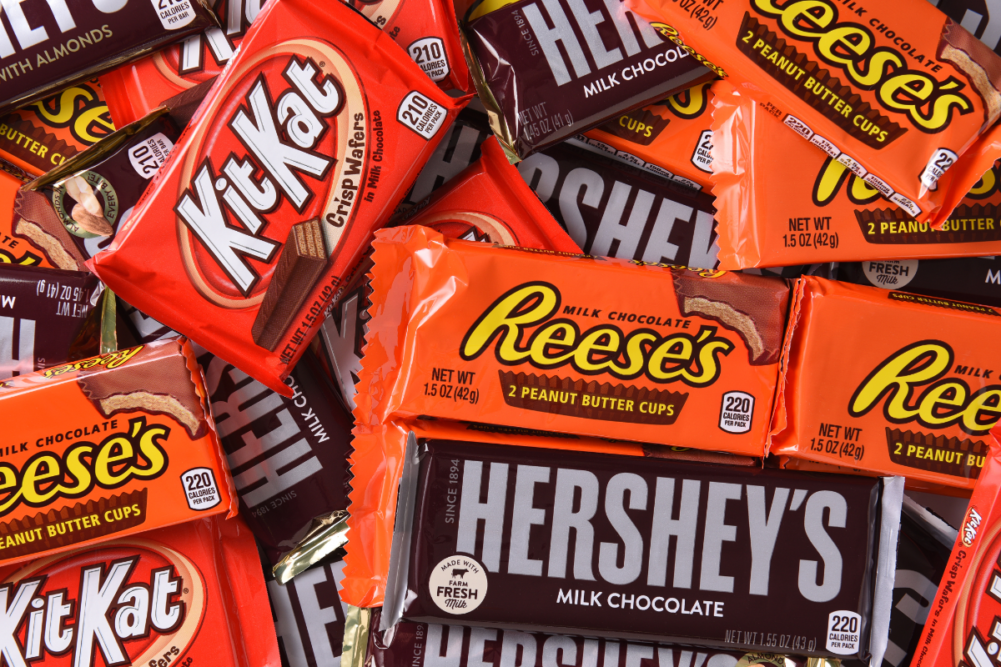HERSHEY, PA. — Higher prices helped offset increases in supply chain costs for The Hershey Co. in the fourth quarter. Strong holiday demand and price increases delivered sales and profit growth, while hikes in sugar, dairy, packaging, labor and shipping costs weighed on margins.
The strong fourth quarter capped a year of double-digit sales and earnings growth for Hershey. Net income in the fiscal year ended Dec. 31, 2021, was $1.48 billion, equal to $7.34 per share on the common stock, up 16% from $1.28 billion, or $6.30 per share, in fiscal 2020. Sales totaled $8.97 billion, up 10% from $8.15 billion in fiscal 2020.
Net income for the three months ended Dec. 31 was $336 million, or $1.67 per share, up from $291 million, or $1.44 per share, in the same period a year ago. Sales for the quarter were $2.33 billion, up from $2.19 billion in the fourth quarter of 2020.
Reflecting how the company has approached acquisitions and product growth in recent years, Hershey is recasting how it reports its financial results. Historically it offered two reportable segments, North America and International/Other. Moving forward, the company will divide its North America business into two segments: North America Confectionery and North America Salty Snacks.
The North America Confectionery segment includes chocolate and nonchocolate confectionery, gum and refreshment products, protein bars, spreads, snack bites and mixes as well as pantry and foodservice lines, while the North America Salty Snacks segment includes ready-to-eat popcorn, baked and trans-fat free snacks, pretzels and other snacks.
For the 12 months ended Dec. 31, operating income in the North America Confectionery segment rose 8.8% to $2.48 billion from $2.27 billion in fiscal 2020. Sales increased 8.5%, to $7.68 billion from $7.08 billion. Operating income for the North America Salty Snacks segment was $101 million, up 33% from $76 million in 2020. Sales increased 27% to $555 million from $438 million.
Pricing remains the main lever driving growth across both segments as the company struggles to keep pace with consumer demand.
“Consumers spending more time at home has clearly benefited some of our brands and categories, because they're around their homes more to consume our products, and our products are more eaten in those types of environments,” said Michele G. Buck, president and chief executive officer of The Hershey Co., during a Feb. 3 conference call with analysts.
Hershey has focused on optimizing demand, getting the most out of existing capacity by reducing complexity and changeovers and prioritizing high velocity stock-keeping units. The company also has invested in new manufacturing lines, added a new distribution center and expanded its labor force.
Still, executives at the company expect capacity constraints will continue in the year ahead.
“Today, we don’t have enough capacity to meet all consumer demand,” said Steven E. Voskuil, senior vice president and chief financial officer at Hershey. “We’ve had four manufacturing lines come online in 2021. We have more in Reese’s, Payday and Jolly Rancher gummies that will come online in 2022, but even with that, we feel like we’re behind.”
The company plans to invest between $550 million and $600 million in the year ahead, including in labor and supply chain capacity. Those investments partially will be offset by list price increases across all segments in fiscal 2022. While Hershey has successfully executed price increases in the past, Ms. Buck told analysts the company will keep a close eye on the impact of broad inflation on consumers. Other potential headwinds include reductions in government stimulus and SNAP benefits.
“We think historical price elasticity is a smart and prudent planning move for us,” she said. “We’re not a category where there’s a big private label component and people can easily say, ‘I’m going to still participate but switch to lower brands.’ That’s always been a benefit for us during times like this, but we do understand the pressure consumers are under.”
Hershey forecast full-year 2022 sales growth between 8% and 10%. The company expects full-year adjusted earnings per share growth of 9% to 11%.




